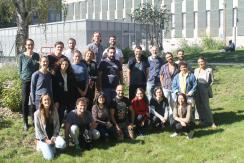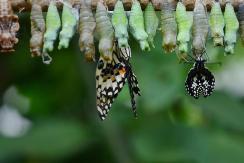COEVOL Multi-Scale Coevolution
Living systems are highly integrated, with a multitude of levels of organization, from molecular and intra-cellular scales to ecosystems. Complex organisms are themselves consortia of macro- and micro-organisms, which work together with their host to build the individual. Yet, each of these organisms can function and evolve in the short term according to its own logic, possibly in conflict with other higher or lower levels, or with other time scales. The once common idea among evolutionists that natural selection results in organisms perfectly adapted to their environment is now severely undermined. Not only because, as the Red Queen explains to Alice, one has to run relentlessly to keep its place in a changing environment, or because past evolutionary history and chance constrain the possibilities of present adaptation, but also because different levels of selection have interests that are generally difficult to reconcile.
Multi-scale coevolution resets classical questions in evolutionary biology
One example, of particular interest is the question of the source of heritable variations. The phenotype of organisms in a population is influenced not only by variations in their nuclear and mitochondrial genomes, the dynamics of which is the object of population genetics, but also more and more patently by the consortium of microbes and genetic elements that constitute its microbiome and virome. The hologenome designates this complex assembly of genetic materials, which obey different rules of transmission and different evolutionary strategies. The ability of symbionts to manipulate host phenotypes or to interfere with each other influences the evolutionary dynamics of all players in ways that are yet poorly understood. In addition, new questions arise, such as the importance of co-adaptation in these systems and their consequences in maintaining cohesive biological systems.
- Symbiosis: a response to and a source of divergent selection
Using a variety of approaches combining experimental evolution, genomic, functional, phenotypic and behavioral data, we aim to test whether symbiosis facilitates diversification and to characterize the underlying microevolutionary processes.
- Ecological networks of horizontal gene transfer
We develop original methods to detect gene transfer and we investigate the factors that influence the routes of gene transfers among microbes but also among insects.
- The interplay between symbiosis, infection and immunity and its evolutionary consequences
We try to understand the intimate interaction of hosts with pathogens, symbionts and transposable elements and how it affects the extended phenotype of the host.
- Transgenerational inheritance and environment changes
We try to decipher the molecular mechanisms that underlie rapid adaptation to environment and to test for transgenerational inheritance of fitness traits.
- Intragenomic conflicts and demography
We are developing models to test whether changes in the demography of the host affect the dynamics of transposable elements.
- The determinism of phenotypic convergence
We study the genomic basis of convergent phenotypic evolution in particular in the case of animals and plants adaptation to increasing temperature and decreasing water.
- Reconciling the tree of life
We develop phylogenetic methods for “reconciling” gene/species or host/symbiont histories and use these methods to explore the bulk of extinct or undescribed species and the history of association of symbiotic microbes with their hosts.
Integrating methods
The methods we use to tackle the questions raised by multi-scale co-evolution extend from theory, modelling and simulation to big data analysis, lab (notably on insects), and to a lesser extent, field activities.
Implication of research, responsibility of researchers and citizen sciences
From our research (some of which have immediate consequences in health, agriculture and ecology) and our concerns about the responsibility of scientists in society, we are committed to promote an “implicative” research. The implicative position means that we try to work on the link between science and society, not only through a one-way communication, applying or explaining our science, but also favoring early discussions on research projects, that may influence our research directions.
Publications
Display of 211 to 240 publications on 710 in total
Tick-Bacteria Mutualism Depends on B Vitamin Synthesis Pathways
Current Biology . 28 ( 12 ) : 1896 - 1902.e5
Journal article
see the publicationCancer Is Not (Only) a Senescence Problem
Trends in Cancer . 4 ( 3 ) : 169 - 172
Journal article
see the publicationAbundance of Bemisia tabaci Gennadius (Hemiptera: Aleyrodidae) and its parasitoids on vegetables and cassava plants in Burkina Faso (West Africa)
Ecology and Evolution . 8 ( 12 ) : 6091-6103
DOI: 10.1002/ece3.4078
Journal article
see the publicationBack and forth Wolbachia transfers reveal efficient strains to control spotted wing drosophila populations
Journal of Applied Ecology . 55 ( 5 ) : 2408-2418
Journal article
see the publicationThe somatic piRNA pathway controls germline transposition over generations
Nucleic Acids Research . 46 ( 18 ) : 9524 - 9536
DOI: 10.1093/nar/gky761
Journal article
see the publicationCoexistence of two sympatric cryptic bat species in French Guiana: insights from genetic, acoustic and ecological data
BMC Evolutionary Biology . 18 ( 1 )
Journal article
see the publicationCoexistence de deux espèces cryptiques de chauves-souris en Guyane française : apprentissages à partir de la génétique de l’acoustique et de l’écologie
Plume de Naturalistes . 2 : 169-190
Journal article
see the publicationCo-occurrence among three divergent plant-castrating fungi in the same Silene host species
Molecular Ecology . 27 ( 16 ) : 3357 - 3370
DOI: 10.1111/mec.14805
Journal article
see the publicationGearing up to handle the mosaic nature of life in the quest for orthologs
Bioinformatics . 34 ( 2 ) : 323-329
Journal article
see the publicationPopulation specific dynamics and selection patterns of transposable element insertions in European natural populations
Molecular Ecology . : 1-17
DOI: 10.1111/mec.14963
Journal article
see the publicationStress affects the epigenetic marks added by natural transposable element insertions in Drosophila melanogaster
Scientific Reports . 8 ( 1 ) : 1-10
Journal article
see the publicationInvolvement of a host Cathepsin L in symbiont-induced cell death
MicrobiologyOpen . 7 ( 5 )
DOI: 10.1002/mbo3.632
Journal article
see the publicationUnbiased Estimate of Synonymous and Nonsynonymous Substitution Rates with Nonstationary Base Composition
Molecular Biology and Evolution . 35 ( 3 ) : 734-742
Journal article
see the publicationRecPhyloXML: a format for reconciled gene trees
Bioinformatics . 34 ( 21 ) : 3646-3652
Journal article
see the publicationOvertraining often results in topologically incorrect species trees with maximum likelihood methods
DOI: 10.1101/140780
Preprint
see the publicationA behavior-manipulating virus relative as a source of adaptive genes for parasitoid wasps
Preprint
see the publicationDeciphering the behaviour manipulation imposed by a virus on its parasitoid host: insights from a dual transcriptomic approach
Parasitology . 145 ( 14 ) : 1979-1989
Journal article
see the publicationImpact of pest management practices on the frequency of insecticide resistance alleles in Bemisia tabaci (Hemiptera: Aleyrodidae) populations in three countries of West Africa
Crop Protection . 104 : 86 - 91
Journal article
see the publicationModeling trophic dependencies and exchanges among insects’ bacterial symbionts in a host-simulated environment
BMC Genomics . 19 : 402
Journal article
see the publicationSterile insect technique and Wolbachia symbiosis as potential tools for the control of the invasive species Drosophila suzukii
Journal of Pest Science . 91 ( 2 ) : 489-503
Journal article
see the publicationAn attempt to select non-genetic variation in resistance to starvation and reduced chill coma recovery time in Drosophila melanogaster
Journal of Experimental Biology . 221 ( 23 ) : jeb186254
DOI: 10.1242/jeb.186254
Journal article
see the publicationTransposable Element Dynamics in an Invasive Species
Congrès National des Éléments Transposables (CNET 2018) .
Conference paper
see the publicationEvaluating the essentiality of the primary endosymbiont of the rice weevil Sitophilus oryzae through genome analysis
6. Meeting of the Spanish Society for Evolutionary Biology (SESBE) .
Poster
see the publicationMultiple convergent supergene evolution events in mating-type chromosomes
Nature Communications . 9 ( 1 ) : 2000
Journal article
see the publicationPhylogenetic signal from rearrangements in 18 Anopheles species by joint scaffolding extant and ancestral genomes
BMC Genomics . 19 ( S2 ) : 1-15
Journal article
see the publicationSex gap in aging and longevity: can sex chromosomes play a role?
Biology of Sex Differences . 9 ( 1 ) : 1-14
Journal article
see the publicationGenetic exchange in eukaryotes through horizontal transfer: connected by the mobilome
Mobile DNA . 9 ( 1 ) : 1-16
Journal article
see the publicationDevelopment of a PCR-RFLP assay to identify Drosophila melanogaster among field-collected larvae
Ecology and Evolution . 8 ( 20 ) : 10067 - 10074
DOI: 10.1002/ece3.4453
Journal article
see the publicationPersistent Interactions with Bacterial Symbionts Direct Mature-Host Cell Morphology and Gene Expression in the Squid-Vibrio Symbiosis
mSystems . 3 ( 5 )
Journal article
see the publication

